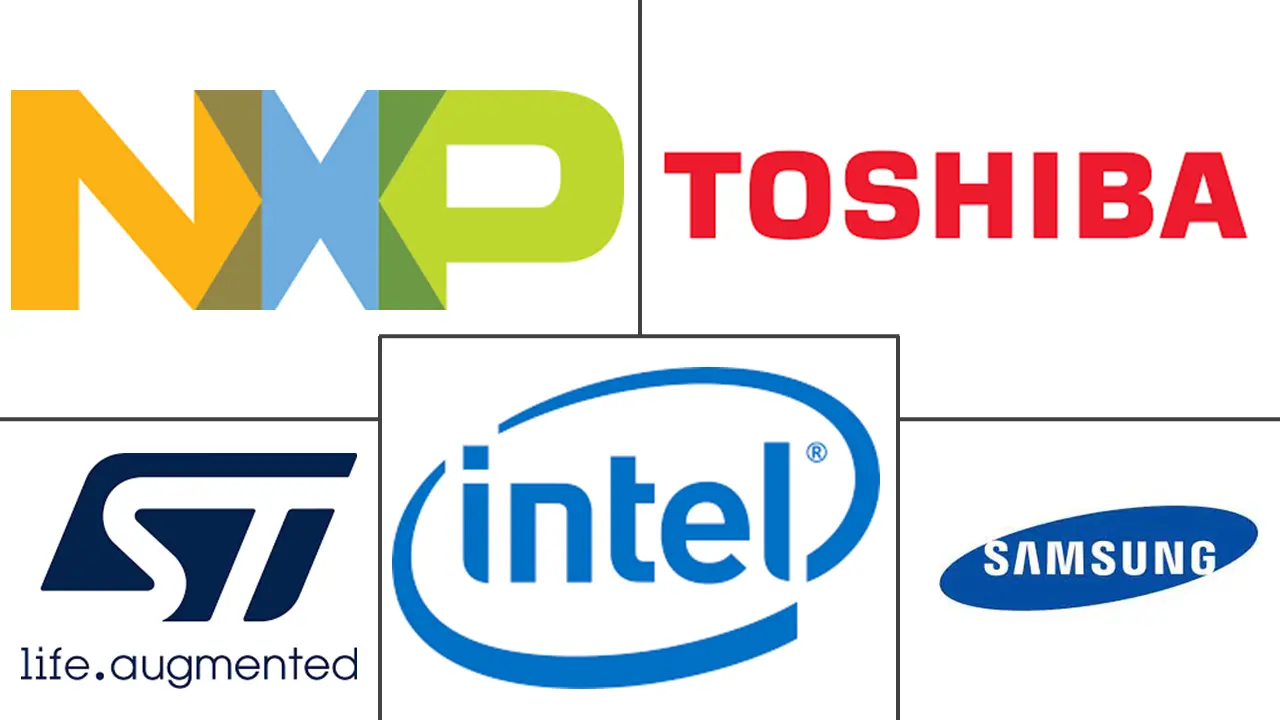Size and Share of APAC Semiconductor Device Market In Aerospace & Defense Industry
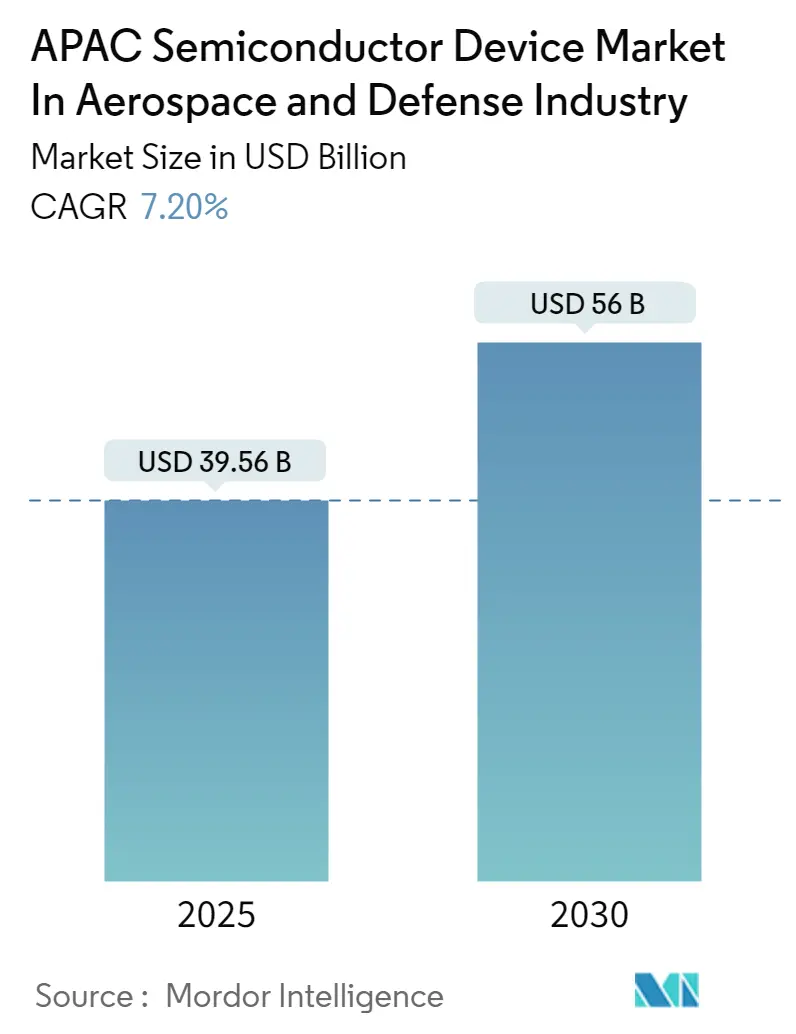
Analysis of APAC Semiconductor Device Market In Aerospace & Defense Industry by Mordor Intelligence
The APAC Semiconductor Device Market In Aerospace & Defense Industry is expected to grow from USD 39.56 billion in 2025 to USD 56.00 billion by 2030, at a CAGR of 7.2% during the forecast period (2025-2030).
- The increasing demand for semiconductor devices from the aerospace and defense industries owing to the increasing air passenger traffic, increasing defense budgets, increasing space exploration activities, etc., is expected to contribute significantly to revenue generation in the coming years; however, a shortage of skilled labor-intensive tasks may impede industry expansion in the coming years.
- The military and aerospace industry's semiconductor market is growing significantly due to the increased upgrading and modernization of aircraft. However, market expansion may be constrained by factors like the high manufacturing cost. The focus of aircraft manufacturers has been to improve and modernize their products to help pilots fly safely. In addition, there is a growing need to update aircraft display screens as cathode ray tubes become obsolete. Lighter and more sophisticated display screens are required to reduce emissions and enable significant fuel savings significantly. Resultantly, the market is likely to grow due to the rising demand for semiconductors used in aircraft electronics systems.
- Space is a massive industry with limitless prospects, and components for space electronics based on semiconductors are needed for all platform functions. Innovation and R&D has been the preferred approach for many companies to secure their positions in the semiconductor and aerospace markets. For instance, STMicroelectronics developed affordable radiation-hardened space satellites in March 2022. The new line of power, analog, and logic ICs in low-cost plastic packages are radiation-hardened and perform crucial tasks for the electronic circuitry of the satellites. A data converter, a voltage regulator, a low-voltage differential signaling transceiver, a line driver, and five logs are among the first nine components in the series that was launched.
- Additionally, semiconductors are used in the defense industry in various systems, including navigation systems, auxiliary power units, fire suppression systems, and communication devices. Military forces are investing in UAV solutions like drones for effective operating systems, which in turn is creating demand for improved semiconductor components. Furthermore, advancements in capability around the region have created the need for modernization and the installation of sophisticated by governments to be prepared for any unprecedented threats and offensive attacks. Consequently fueling the market's expansion during the anticipated time.
- On the flip side, the semiconductor industry is considered to be one of the most complex industries, not only due to more than 500 processing steps involved in the manufacturing and various products, but also the harsh environment it faces, e.g., the volatile electronic market and the unpredictable demand. Depending on the complexity of the manufacturing process, there can be up to 1,400 process steps in the overall manufacturing of semiconductor wafers alone. Transistors are formed on the lowest layer, but the process is repeated as numerous layers of circuits are formed to create the final product. The complexity of manufacturing semiconductor devices is likely to restrain the growth of the studied market.
Insights and Trends of APAC Semiconductor Device Market In Aerospace & Defense Industry
Increase in Defense Budgets Across the Globe are Expected to Drive the Market's Growth
- Semiconductor devices have various applications in the defense industry, ranging from advanced radar and communication systems to military-grade devices used by various defense departments. Advanced semiconductors play an essential role in the defense industry particularly in electronic components for sophisticated military systems. Gallium nitride (GaN) semiconductor devices, in particular, areincreasingly used in defense and aerospace applications due to their high performance, high efficiency, and ability to operate in harsh environments.
- Additionally, it is anticipated that the expansion of aircraft modernization and modifications will be a major driver of semiconductor industry growth in the defense sectors. To ensure pilot safety, aircraft manufacturers have primarily concentrated on updating and improving their products. The need to replace the outdated cathode ray tubes used in airline screens is growing more and more urgent. Display panels must be lighter and more technologically advanced if emissions are to be drastically reduced and significant fuel savings are to be realized. Consequently, a growing market will result from the rising demand for semiconductors used in aircraft electronic systems.
- The increase in defense expenditure in various regions across the globe is anticipated to boost the growth of the studied market. For instance, the Indian Union Budget for FY24 envisages a total outlay of USD 550 billion. USD 72 billion or 13.18% of the overall budget has been allotted to the Ministry of Defense. The entire defense budget represents an increase of USD 8.35 billion, or 13%, over the budget for 2022-23. The non-salary revenue/operational allocation has been raised from USD 7.63 billion in Budget Estimates 2022-23 to USD 11 billion in BE 2023-24 to support the maintenance of weapon systems, platforms, ships/aircraft, and their logistics, improve fleet serviceability, etc.
- Similarly, the 2023-2027 midterm defense strategy was unveiled by the South Korean Ministry of National Defense (MND) on December 28, 2022. The South Korean government announced that it would spend USD 268.8 billion over the next five years, which translates to an annual rise in defense spending of almost 6.8%. The 'Korean Triad System,' which includes the 'Kill Chain' and allows for preemptive strikes in the event of any indications of North Korean strikes, will be acquired with a significant percentage of the government's budget being prioritized. The MND would spend money to purchase 20 F-35A stealth jets and KTSSMs (Korea Tactical Surface-to-Surface Missiles) for this.
- Moreover, according to Ministry of Défense (Japan), in the fiscal year 2023, Japan's national defense was initially allocated JPY 6.82 trillion (USD 43 billion). In comparison to prior years, this was a significant rise as a result of the Japanese government's new policy to strengthen the country's defense capabilities. Such huge spending in defense would drive the demand for the studied market.
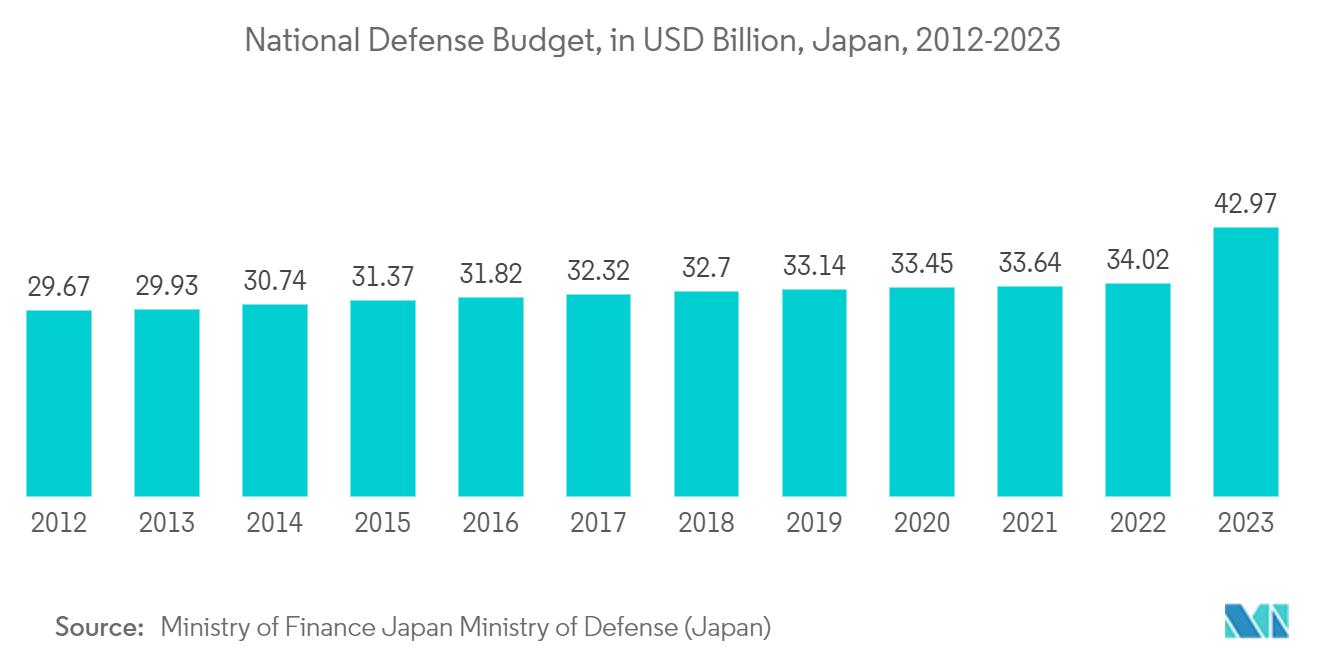
China is Expected to Witness a High Market Growth
- China has a thriving aerospace and defense industry, primarily overseen by the Aviation Industry Corporation of China (AVIC), a state-owned conglomerate. In addition to AVIC, there are other major players in the Chinese defense market, such as Sinoma International Engineering, Avicopter, China Aerospace Science and Technology Corporation (CASC), China Electronics Technology Group, etc. China also boasts an extensive range of military aircraft. The presence of prominent aerospace and defense players in the country is likely to offer lucrative opportunities for the growth of the studied market.
- The Chinese government is undertaking several measures to advance its aerospace and defense industry. For instance, China's new five-year plan for 2021-25, announced in March 2021, established a comprehensive plan for boosting basic research as a critical priority. Semiconductors have been designated as one of the seven areas given priority in terms of resources and funding. Firms involved in designing and developing nanometer-scale integrated circuits that perform the primary tasks that make electronic devices work, such as computing, storage, network connectivity, and power management, are given significant importance.
- Further, China recently established various committees and policies to promote and regulate the development of its domestic integrated circuit (IC) industry. The Ministry of Industry and Information Technology established the National Integrated Circuit Committee to set standards and promote the industry. The Chinese government released guidelines and policies, such as the National Integrated Circuit Industry (National IC Plan) and the China Integrated Circuit Investment Industry Fund, to support the development of the industry. Additionally, China implemented export controls on advanced computing integrated circuits (ICs). Such policies and standards would ensure integrated circuits' quality and efficient functioning.
- Moreover, the number of newly registered chip-related companies in China more than tripled in the first five months of 2022 from the same period in the last two years. It is a new sign that China is sparing no effort in its goal of self-sufficiency in semiconductors, for which the country relied heavily on imports and US technologies to satisfy domestic demand. To that extent, in 2022, Semiconductor Manufacturing International Corp (SMIC) set aside USD 5 billion for capital spending, up from USD 4.5 billion in 2021.
- In March 2022, according to draught budget recommendations, the Chinese government proposed a defense budget of USD 230 billion for 2022, a 7.1% rise year on year. China's increase in defense spending coincides with the People's Liberation Army's increasing muscle-flexing in the vital Indo-Pacific. In March 2023, China announced a draft budget 023, which would see the country's annual defense budget rise to CNY 1.5537 trillion (USD 0.21 billion), an increase of 7.2% from 2022. The increasing defense budgets in the country are likely to boost the growth of the studied market. According to SIPRI, China's military spending in 2023, is USD 296 billion.
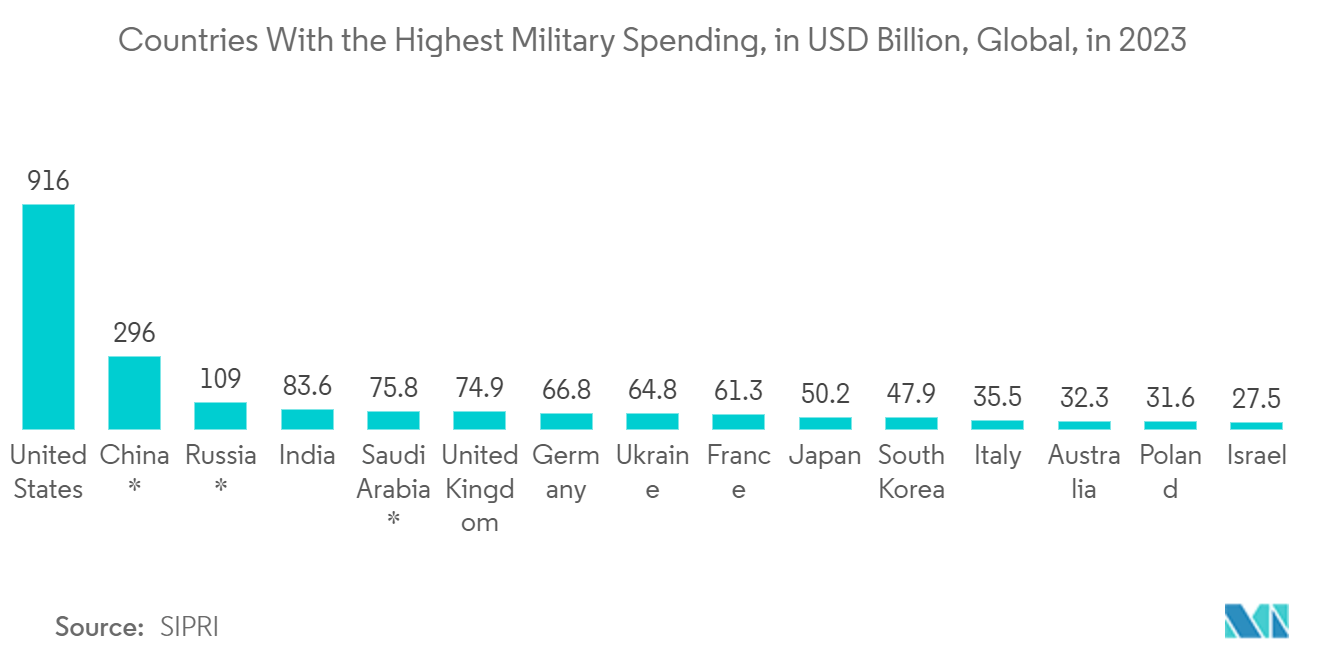
Competitive Landscape
The Asia-Pacific Semiconductor Device Market in the Aerospace & Defense Industry is fragmented, with several players like Intel Corporation, Kyocera Corporation, STMicroelectronics, NXP Semiconductors, etc. The market players are constantly striving to innovate new products and solutions to cater to the evolving needs of consumers by investing in R&D, partnerships, mergers, acquisitions, etc. Some of the recent developments in the market are:
- March 2023: The Chinese integrated circuit designer for Orbita aircraft Science and Technology announced starting a CNY 808 million (USD116 million) project to produce aircraft chip and computer products. The project's five-year goal is to create a new generation of system-on-chip integrated circuits for satellites, spacecraft, and planes. It will primarily employ the chips to build three different types of satellite platform computers.
- October 2022: A strategic alliance was launched by American aerospace and defense firm General Atomics and Indian digital startup 3rdiTech. It is expected to significantly boost the AtmaNirbhar Bharat campaign and the Make-in-India drive. The two companies announced a strategic alliance to co-design and co-develop advanced semiconductor technology products. 3rdiTech is India's first and only firm that manufactures chips for image and laser applications. It won the Indian Ministry of Defence's flagship iDEX program after working closely with the Indian Air Force. It collaborates with all departments of the Indian military and has received contracts and accolades from many branches of the US military.
Leaders of APAC Semiconductor Device Market In Aerospace & Defense Industry
-
Intel Corporation
-
STMicroelectronics NV
-
Toshiba Corporation
-
NXP Semiconductors NV
-
Samsung Electronics Co. Ltd
- *Disclaimer: Major Players sorted in no particular order
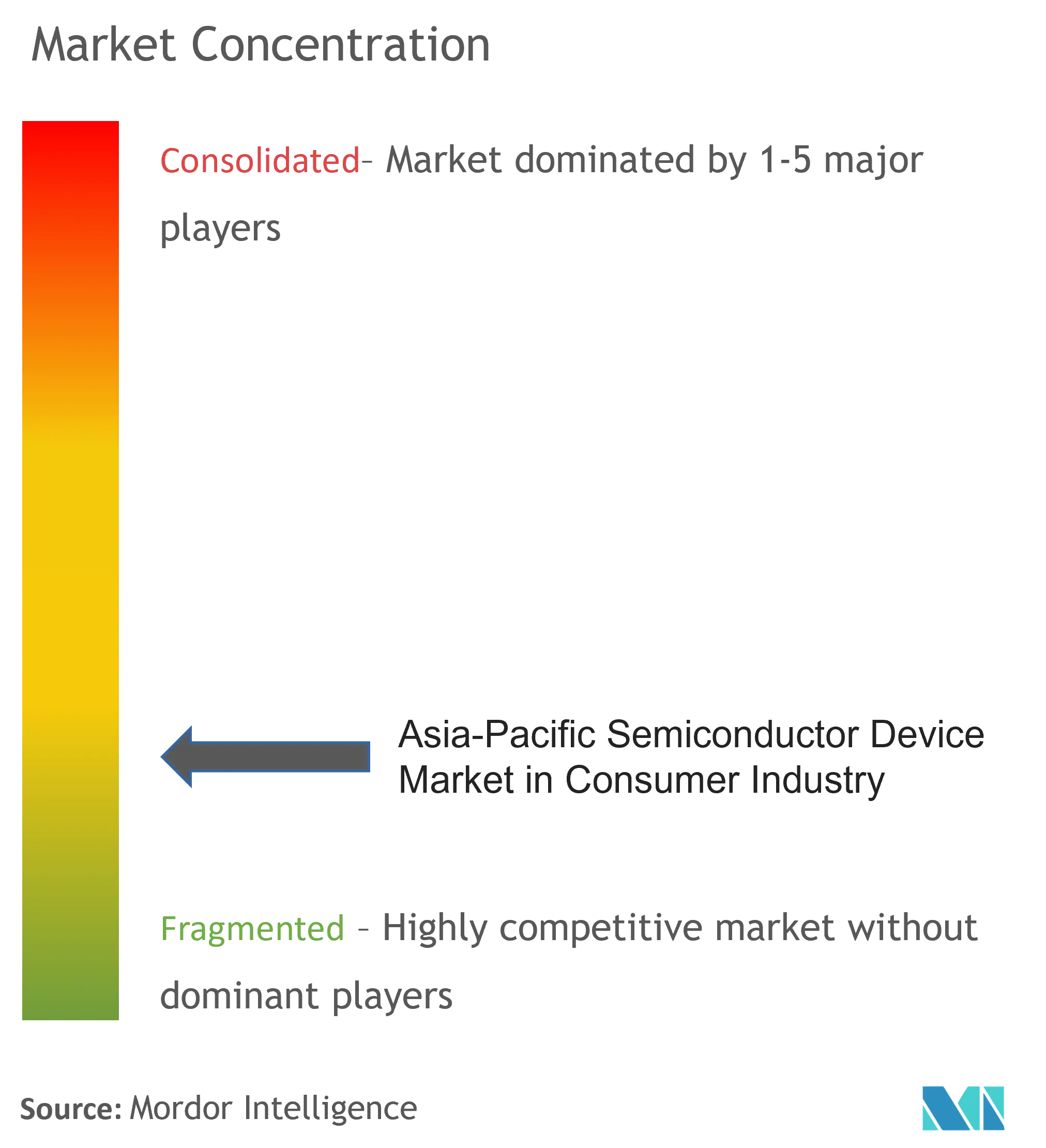
Recent Industry Developments
- February 2023: STMicroelectronics, a global semiconductor leader serving customers in a wide range of electronics applications, expanded its STM32 family of advanced microcontrollers (MCUs) with additional STM32U5 devices that boost performance while reducing power consumption for longer runtimes and energy efficiency. The STM32U5 has also achieved NIST-embedded random-number entropy source certification, making it the industry's first. The new MCUs increase the capacity of code and data storage to 128Kbyte Flash for low-cost applications while also introducing high-density versions for complicated applications and sophisticated smartphone-like user interfaces.
- September 2022: Showa Denko Materials Co. Ltd announced plans to expand its manufacturing capacity and assessment activities for "CMP slurries," polishing materials to fabricate semiconductor integrated circuits. The company will build a new plant and install more production and evaluation equipment at Yamazaki Works and its Katsuta manufacturing site, as well as its consolidated subsidiary Showa Denko Semiconductor Materials (Taiwan) Co. Ltd in Taiwan.
Scope of Report on APAC Semiconductor Device Market In Aerospace & Defense Industry
Semiconductor devices are electronic components that utilize the electronic properties of semiconductor materials, like silicon, germanium, gallium arsenide, and organic semiconductors.
The Asia-Pacific semiconductor device market in aerospace & defense industry is segmented by device type (discrete semiconductors, optoelectronics, sensors, integrated circuits [analog, logic, memory, micro [microprocessors, microcontrollers, digital signal processors]]), by country (China, Japan, India, Korea, Taiwan). The report offers market forecasts and size in value (USD) for all the above segments.
| Discrete Semiconductors | ||
| Optoelectronics | ||
| Sensors | ||
| Integrated Circuits | Analog | |
| Logic | ||
| Memory | ||
| Micro | Microprocessors (MPU) | |
| Microcontrollers (MCU) | ||
| Digital Signal Processors | ||
| Japan |
| China |
| India |
| South Korea |
| Taiwan |
| By Device Type | Discrete Semiconductors | ||
| Optoelectronics | |||
| Sensors | |||
| Integrated Circuits | Analog | ||
| Logic | |||
| Memory | |||
| Micro | Microprocessors (MPU) | ||
| Microcontrollers (MCU) | |||
| Digital Signal Processors | |||
| By Geography | Japan | ||
| China | |||
| India | |||
| South Korea | |||
| Taiwan | |||
Key Questions Answered in the Report
How big is the APAC Semiconductor Device Market In Aerospace & Defense Industry?
The APAC Semiconductor Device Market In Aerospace & Defense Industry size is expected to reach USD 39.56 billion in 2025 and grow at a CAGR of 7.20% to reach USD 56.00 billion by 2030.
What is the current APAC Semiconductor Device Market In Aerospace & Defense Industry size?
In 2025, the APAC Semiconductor Device Market In Aerospace & Defense Industry size is expected to reach USD 39.56 billion.
Who are the key players in APAC Semiconductor Device Market In Aerospace & Defense Industry?
Intel Corporation, STMicroelectronics NV, Toshiba Corporation, NXP Semiconductors NV and Samsung Electronics Co. Ltd are the major companies operating in the APAC Semiconductor Device Market In Aerospace & Defense Industry.
What years does this APAC Semiconductor Device Market In Aerospace & Defense Industry cover, and what was the market size in 2024?
In 2024, the APAC Semiconductor Device Market In Aerospace & Defense Industry size was estimated at USD 36.71 billion. The report covers the APAC Semiconductor Device Market In Aerospace & Defense Industry historical market size for years: 2019, 2020, 2021, 2022, 2023 and 2024. The report also forecasts the APAC Semiconductor Device Market In Aerospace & Defense Industry size for years: 2025, 2026, 2027, 2028, 2029 and 2030.
Page last updated on:
Report on APAC Semiconductor Device Market In Aerospace & Defense Industry
Statistics for the 2025 APAC Semiconductor Device In Aerospace & Defense Industry market share, size and revenue growth rate, created by Mordor Intelligence™ Industry Reports. APAC Semiconductor Device In Aerospace & Defense Industry analysis includes a market forecast outlook for 2025 to 2030 and historical overview. Get a sample of this industry analysis as a free report PDF download.
